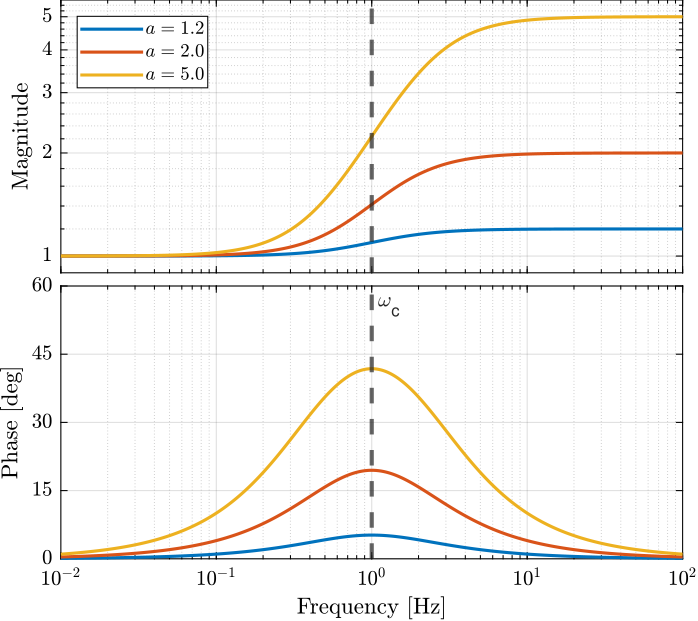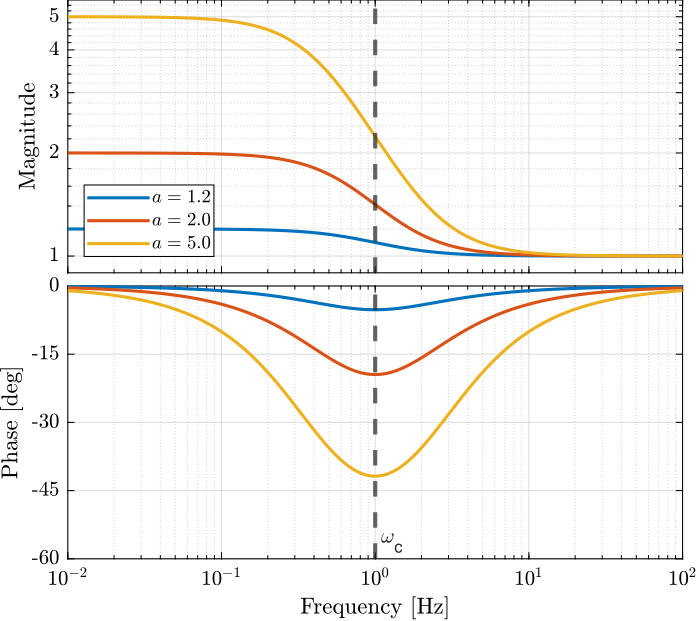25 KiB
Bank of Linear Filters - Matlab
- Low Pass
- High Pass
- Band Pass
- Notch
- Chebyshev
- Lead - Lag
- Complementary
- Performance Weight
- Combine Filters
- Filters representing noise
Low Pass
First Order Low Pass Filter
\[ H(s) = \frac{1}{1 + s/\omega_0} \]
Parameters:
- $\omega_0$: cut-off frequency in [rad/s]
Characteristics:
- Low frequency gain of $1$
- Roll-off equals to -20 dB/dec
Matlab code:
w0 = 2*pi; % Cut-off Frequency [rad/s]
H = 1/(1 + s/w0);
Second Order
\[ H(s) = \frac{1}{1 + 2 \xi / \omega_0 s + s^2/\omega_0^2} \]
Parameters:
- $\omega_0$:
- $\xi$: Damping ratio
Characteristics:
- Low frequency gain: 1
- High frequency roll off: - 40 dB/dec
Matlab code:
w0 = 2*pi; % Cut-off frequency [rad/s]
xi = 0.3; % Damping Ratio
H = 1/(1 + 2*xi/w0*s + s^2/w0^2);
Combine multiple first order filters
\[ H(s) = \left( \frac{1}{1 + s/\omega_0} \right)^n \]
Matlab code:
w0 = 2*pi; % Cut-off frequency [rad/s]
n = 3; % Filter order
H = (1/(1 + s/w0))^n;
High Pass
First Order
\[ H(s) = \frac{s/\omega_0}{1 + s/\omega_0} \]
Parameters:
- $\omega_0$: cut-off frequency in [rad/s]
Characteristics:
- High frequency gain of $1$
- Low frequency slow of +20 dB/dec
Matlab code:
w0 = 2*pi; % Cut-off frequency [rad/s]
H = (s/w0)/(1 + s/w0);
Second Order
\[ H(s) = \frac{s^2/\omega_0^2}{1 + 2 \xi / \omega_0 s + s^2/\omega_0^2} \]
Parameters:
- $\omega_0$:
- $\xi$: Damping ratio
Matlab code:
w0 = 2*pi; % [rad/s]
xi = 0.3;
H = (s^2/w0^2)/(1 + 2*xi/w0*s + s^2/w0^2);
Combine multiple filters
\[ H(s) = \left( \frac{s/\omega_0}{1 + s/\omega_0} \right)^n \]
Matlab code:
w0 = 2*pi; % [rad/s]
n = 3;
H = ((s/w0)/(1 + s/w0))^n;
TODO Band Pass
Second Order
Notch
Second Order
Parameters:
- $\omega_n$: frequency of the notch
- $g_c$: gain at the notch frequency
- $\xi$: damping ratio (notch width)
Matlab code:
gc = 0.02;
xi = 0.1;
wn = 2*pi;
H = (s^2 + 2*gm*xi*wn*s + wn^2)/(s^2 + 2*xi*wn*s + wn^2);

TODO Chebyshev
Chebyshev Type I
n = 4; % Order of the filter
Rp = 3; % Maximum peak-to-peak ripple [dB]
Wp = 2*pi; % passband-edge frequency [rad/s]
[A,B,C,D] = cheby1(n, Rp, Wp, 'high', 's');
H = ss(A, B, C, D);Lead - Lag
Lead
Parameters:
- $\omega_c$: frequency at which the phase lead is maximum
- $a$: parameter to adjust the phase lead, also impacts the high frequency gain
Characteristics:
- the low frequency gain is $1$
- the high frequency gain is $a$
- the phase lead at $\omega_c$ is equal to (Figure fig:filter_lead_effect_a_phase): \[ \angle H(j\omega_c) = \tan^{-1}(\sqrt{a}) - \tan^{-1}(1/\sqrt{a}) \]
Matlab code:
a = 0.6; % Amount of phase lead / width of the phase lead / high frequency gain
wc = 2*pi; % Frequency with the maximum phase lead [rad/s]
H = (1 + s/(wc/sqrt(a)))/(1 + s/(wc*sqrt(a)));

Lag
Parameters:
- $\omega_c$: frequency at which the phase lag is maximum
- $a$: parameter to adjust the phase lag, also impacts the low frequency gain
Characteristics:
- the low frequency gain is increased by a factor $a$
- the high frequency gain is $1$ (unchanged)
- the phase lag at $\omega_c$ is equal to (Figure fig:filter_lag_effect_a_phase): \[ \angle H(j\omega_c) = \tan^{-1}(1/\sqrt{a}) - \tan^{-1}(\sqrt{a}) \]
Matlab code:
a = 0.6; % Amount of phase lag / width of the phase lag / high frequency gain
wc = 2*pi; % Frequency with the maximum phase lag [rad/s]
H = (wc*sqrt(a) + s)/(wc/sqrt(a) + s);

TODO Complementary
TODO Performance Weight
Nice combination
n = 2; w0 = 2*pi*11; G0 = 1/10; G1 = 1000; Gc = 1/2;
wL = Gc*(((G1/Gc)^(1/n)/w0*sqrt((1-(G0/Gc)^(2/n))/((G1/Gc)^(2/n)-1))*s + (G0/Gc)^(1/n))/(1/w0*sqrt((1-(G0/Gc)^(2/n))/((G1/Gc)^(2/n)-1))*s + 1))^n;
n = 3; w0 = 2*pi*9; G0 = 10000; G1 = 0.1; Gc = 1/2;
wH = Gc*(((G1/Gc)^(1/n)/w0*sqrt((1-(G0/Gc)^(2/n))/((G1/Gc)^(2/n)-1))*s + (G0/Gc)^(1/n))/(1/w0*sqrt((1-(G0/Gc)^(2/n))/((G1/Gc)^(2/n)-1))*s + 1))^n;Alternative
w0 = 2*pi; % [rad/s]
A = 1e-2;
M = 5;
H = (s/sqrt(M) + w0)^2/(s + w0*sqrt(A))^2;
TODO Combine Filters
Additive
- Explain how phase and magnitude combine
Multiplicative
TODO Filters representing noise
Let's consider a noise $n$ that is shaped from a white-noise $\tilde{n}$ with unitary PSD ($\Phi_\tilde{n}(\omega) = 1$) using a transfer function $G(s)$. The PSD of $n$ is then: \[ \Phi_n(\omega) = |G(j\omega)|^2 \Phi_{\tilde{n}}(\omega) = |G(j\omega)|^2 \]
The PSD $\Phi_n(\omega)$ is expressed in $\text{unit}^2/\text{Hz}$.
And the root mean square (RMS) of $n(t)$ is: \[ \sigma_n = \sqrt{\int_{0}^{\infty} \Phi_n(\omega) d\omega} \]
First Order Low Pass Filter
\[ G(s) = \frac{g_0}{1 + \frac{s}{\omega_c}} \]
g0 = 1; % Noise Density in unit/sqrt(Hz)
wc = 1; % Cut-Off frequency [rad/s]
G = g0/(1 + s/wc);
% Frequency vector [Hz]
freqs = logspace(-3, 3, 1000);
% PSD of n in [unit^2/Hz]
Phi_n = abs(squeeze(freqresp(G, freqs, 'Hz'))).^2;
% RMS value of n in [unit, rms]
sigma_n = sqrt(trapz(freqs, Phi_n))\[ \sigma = \frac{1}{2} g_0 \sqrt{\omega_c} \] with:
- $g_0$ the Noise Density of $n$ in $\text{unit}/\sqrt{Hz}$
- $\omega_c$ the bandwidth over which the noise is located, in rad/s
- $\sigma$ the rms noise
If the cut-off frequency is to be expressed in Hz: \[ \sigma = \frac{1}{2} g_0 \sqrt{2\pi f_c} = \sqrt{\frac{\pi}{2}} g_0 \sqrt{f_c} \]
Thus, if a sensor is said to have a RMS noise of $\sigma = 10 nm\ rms$ over a bandwidth of $\omega_c = 100 rad/s$, we can estimated the noise density of the sensor to be (supposing a first order low pass filter noise shape): \[ g_0 = \frac{2 \sigma}{\sqrt{\omega_c}} \quad \left[ m/\sqrt{Hz} \right] \]
2*10e-9/sqrt(100)2e-09
6*0.5*20e-12*sqrt(2*pi*100)1.504e-09